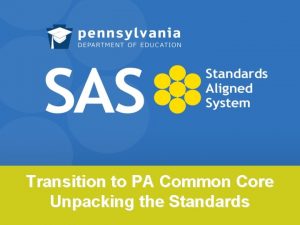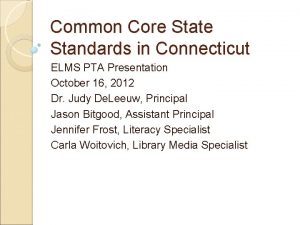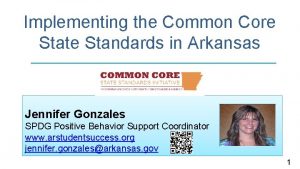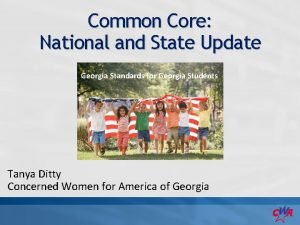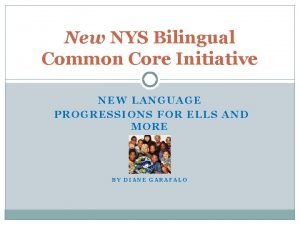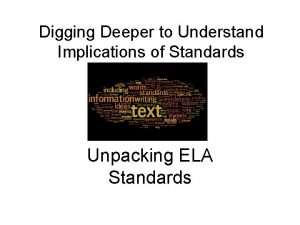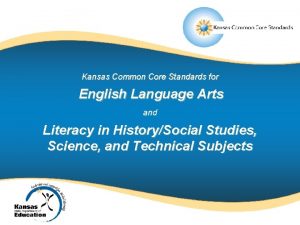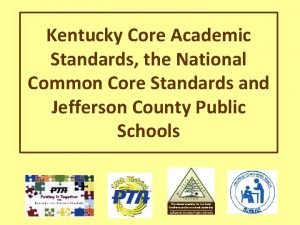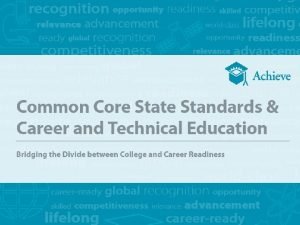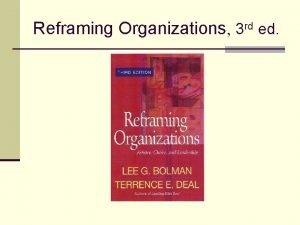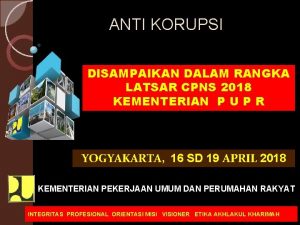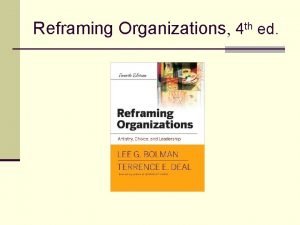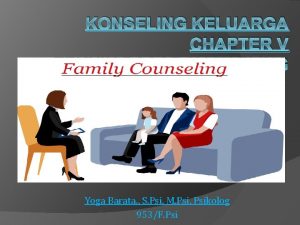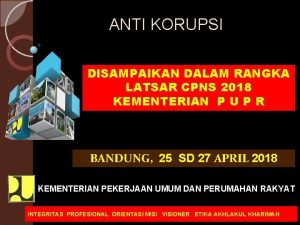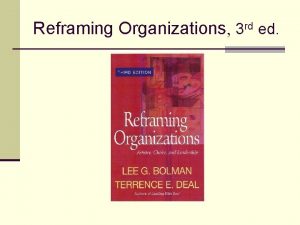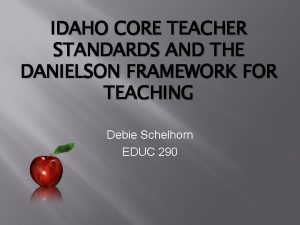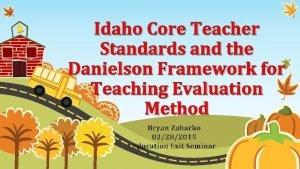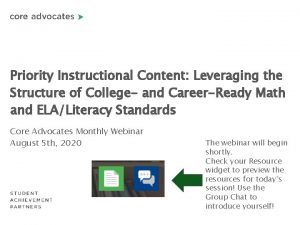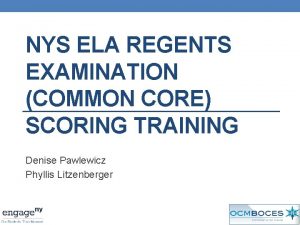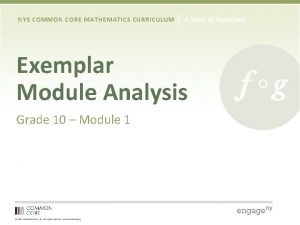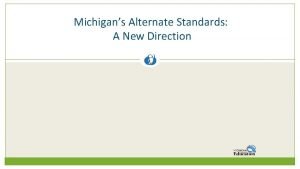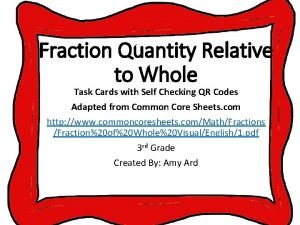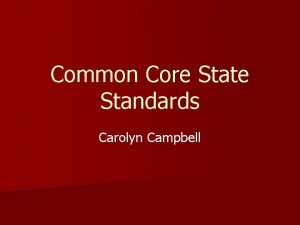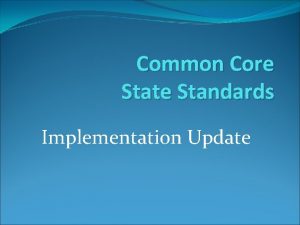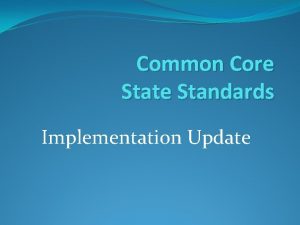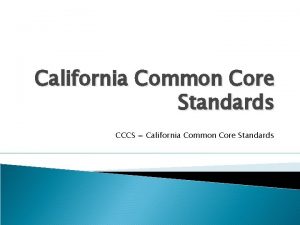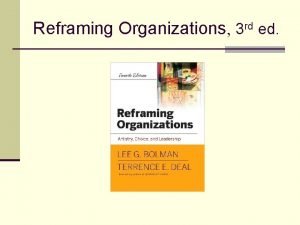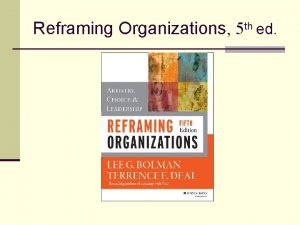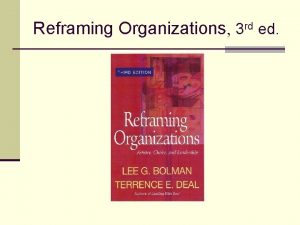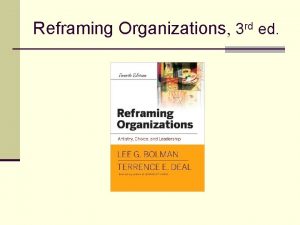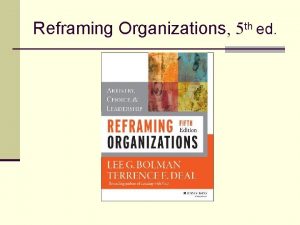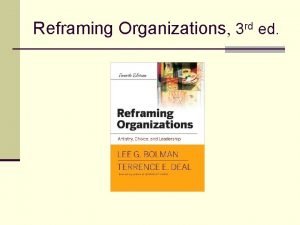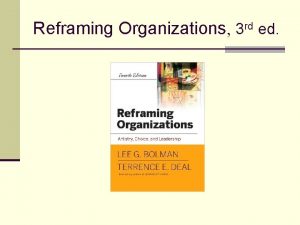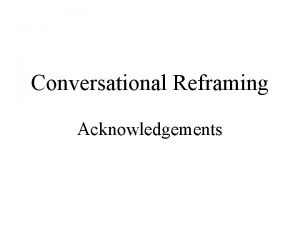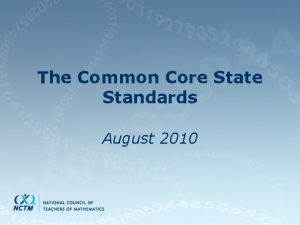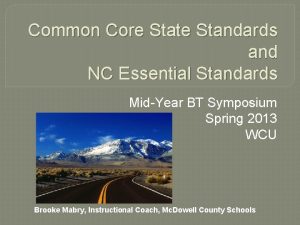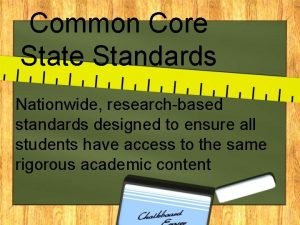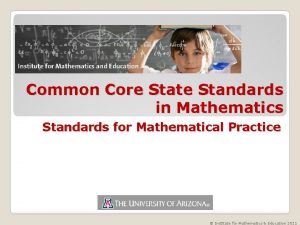Reframing the Work Common Core State Standards Sandra

































- Slides: 33

Reframing the Work – Common Core State Standards Sandra Alberti Student Achievement Partners @salberti @achievethecore #CCSS #Core. Advocates

Agenda • Background – why are we doing this • The Shifts – what and why • Implications – Assessment, Teacher Feedback, Communication • Q&A PAGE 2

Student Achievement Partners – Who We Are • SAP is a nonprofit organization founded by three of the contributing authors of the Common Core State Standards • Currently a team of approximately 30; office in NY and team members located throughout the country • Funded by foundations: GE Foundation, Hewlett Foundation, Bill & Melinda Gates Foundation and The Helmsley Charitable Trust Our mission: • Student Achievement Partners is devoted to accelerating student achievement by supporting effective and innovative implementation of the CCSS. PAGE 3

Our Principles – How we approach the work WE HOLD NO INTELLECTUAL PROPERTY Our goal is to create and disseminate high quality materials as widely as possible. All resources that we create are open source and available at no cost. We encourage states, districts, schools, and teachers to take our resources and make them their own. WE DO NOT COMPETE FOR STATE, DISTRICT OR FEDERAL CONTRACTS Ensuring that states and districts have excellent materials for teachers and students is a top priority. We do not compete for these contracts because we work with our partners to develop high quality RFPs that support the Core Standards. WE DO NOT ACCEPT MONEY FROM PUBLISHERS We work with states and districts to obtain the best materials for teachers and students. We are able to independently advise our partners because we have no financial interests with any publisher of education materials. Our independence is essential to our work. PAGE 4

Standards-Based Instruction – Clear expectations – Clear connection of classroom activities to expectations – Clear information on student progress toward meeting expectations. AKA assessment PAGE 5

Why are we doing this? We have had standards. Before CCSS we had standards, but rarely did we have standards-based instruction. ✓ Long lists of broad, vague statements ✓ Mysterious assessments ✓ Coverage mentality ✓ Focused on teacher behaviors – “the inputs” Is it working? ? for students? ? PAGE 6

A Conversation about Standards - Communication ✓ Standards aligned vs. Standards based ✓ Standards vs. Standardization ✓ Standards vs. Curriculum ✓ Not a ceiling, but a message about priority ✓ Based on evidence v. Researched ✓ Focus, not simplify the work PAGE 7

Principles of Common Core State Standards Fewer - Clearer - Higher (Deeper) • Aligned to requirements for college and career readiness • Based on evidence • Honest about time PAGE 8

Implications • What implications do Standards have on what we teach? • What implications do Standards have on how we teach? This effort is about much more than implementing the next version of the standards: It is about preparing all students for success in college and careers. For opportunities PAGE 9

ELA/Literacy: 3 shifts 1. Building knowledge through content-rich nonfiction 2. Reading, writing, and speaking grounded in evidence from text, both literary and informational PAGE 10

Non-Text-Dependent In “Casey at the Bat, ” Casey strikes out. Describe a time when you failed at something. What makes Casey’s experiences at bat humorous? In “Letter From a Birmingham Jail, ” Dr. King discusses nonviolent protest. Discuss a time when you wanted to fight against something that you felt was unfair. What can you infer from King’s letter about the letter that he received? From “The Adventures of Tom Sawyer, ” have students identify the different methods of removing warts that Tom and Huck talk about. Ask students to devise their own charm to remove warts. Are there cultural ideas or artifacts from the current time that could be used in the charm? Why does Tom hesitate to allow Ben to paint the fence? How does Twain construct his sentences to reflect that hesitation? What effect do Tom’s hesitations have on Ben? PAGE 11

Example? • EXAMPLES James Watson used time away from his laboratory and a set of models similar to preschool toys to help him solve the puzzle of DNA. In an essay discuss how play and relaxation help promote clear thinking and problem solving. PAGE 12

ELA/Literacy: 3 shifts 1. Building knowledge through content-rich nonfiction 2. Reading, writing, and speaking grounded in evidence from text, both literary and informational 3. Regular practice with complex text and its academic language PAGE 13

Mathematics: 3 shifts 1. Focus: Focus strongly where the standards focus. PAGE 14

The shape of math in A+ countries Mathematics topics intended at each grade by at least two-thirds of A+ countries 1 Schmidt, Mathematics topics intended at each grade by at least twothirds of 21 U. S. states Houang, & Cogan, “A Coherent Curriculum: The Case of Mathematics. ” (2002). PAGE 15

Priorities in Mathematics Grade Focus Areas in Support of Rich Instruction and Expectations of Fluency and Conceptual Understanding K– 2 Addition and subtraction - concepts, skills, and problem solving and place value 3– 5 Multiplication and division of whole numbers and fractions – concepts, skills, and problem solving 6 7 8 Ratios and proportional relationships; early expressions and equations Ratios and proportional relationships; arithmetic of rational numbers Linear algebra and linear functions PAGE 16

Mathematics: 3 shifts 1. Focus: Focus strongly where the standards focus. 2. Coherence: Think across grades, and link to major topics PAGE 17

Coherence: Link to major topics within grades Example: data representation Standard 3. MD. 3 PAGE 18

Mathematics: 3 shifts 1. Focus: Focus strongly where the standards focus. 2. Coherence: Think across grades, and link to major topics 3. Rigor: In major topics, pursue conceptual understanding, procedural skill and fluency, and application PAGE 19

Required Fluencies in K-6 Grade Standard Required Fluency K K. OA. 5 Add/subtract within 5 1 1. OA. 6 Add/subtract within 10 2 2. OA. 2 2. NBT. 5 Add/subtract within 20 (know single-digit sums from memory) Add/subtract within 100 3 3. OA. 7 3. NBT. 2 Multiply/divide within 100 (know single-digit products from memory) Add/subtract within 1000 4 4. NBT. 4 Add/subtract within 1, 000 5 5. NBT. 5 Multi-digit multiplication 6 6. NS. 2, 3 Multi-digit division Multi-digit decimal operations PAGE 20

Conceptual understanding of place value…? PAGE 21

Conceptual understanding of place value…? PAGE 22

Power of the Shifts • Know them – both the what and the why • Internalize them • Apply them to your decisions about ✓ ✓ ✓ Time Energy Resources Assessments Conversations with parents, students, colleagues PAGE 23

Assessment Implications

Clearing the Air About Assessment • Issues of Trust • Issues of Quality • Issues of Alignment • Issues of Value • Issues of Purpose: Diagnostic, Formative, Summative • Issues of Standardized PAGE 25

Assessment Paradigm Shift – Next Generation • Assessments worthy of instructional imitation • Assessments that are not an interruption to instruction • Assessments that deliver valuable, actionable, valued information PAGE 26

Instructional Implications Am I Doing the Core?

Purpose of the Coaching Tool • Designed to guide effective integration of the Common Core Shifts into instructional practice • Intended to help teachers in developing their practice through: ‒ Teacher self-reflection ‒ Teacher-to-teacher learning in PLCs, grade-level meetings or other collaborative structures ‒ Feedback from instructional coaches and leaders • Not designed for evaluative purposes All guides are available at achievethecore. org/instructional-practice. PAGE 28

Coaching Tool: Versions • The Coaching Tool exists for a single lesson and for over the course of the year • Coaching Tools by subject and grade: - ELA/literacy (grades K-2; grades 3 -12; History/Social Studies, Science & Technical Subjects) - Mathematics (K-8, HS) PAGE 29

Coaching Tool: Actions and Indicators • Each Coaching Tool for a single lesson has 3 Core Actions • Each Core Action has 3 -7 indicators (look-fors) - Each indicator has an area to note the evidence that has been observed or gathered - Indicators include a binary (yes/no) or 4 -point scale that may be used to further focus the evidence collected PAGE 30

Key Characteristics of Leading Organizations ü Systems Thinking ü Learning Organizations ü Know – Really Know – the expectations PAGE 31

Far and away the best prize that life has to offer is the chance to work hard at work worth doing. Theodore Roosevelt PAGE 32

Thank You! Sandra Alberti salberti@studentsachieve. net www. achievethecore. org/salberti Twitter: @salberti
 Common core state standards pa
Common core state standards pa Common core state standards ct
Common core state standards ct Common core state standards missouri
Common core state standards missouri Common core standards arkansas
Common core standards arkansas Georgia common core standards
Georgia common core standards Bilingual common core progressions
Bilingual common core progressions Unpacking standards template
Unpacking standards template Kansas english standards
Kansas english standards Common core standards ky
Common core standards ky Common career technical core standards
Common career technical core standards Reframing organizational culture
Reframing organizational culture Identifikasi dan penyelarasan nilai anti korupsi
Identifikasi dan penyelarasan nilai anti korupsi Reframing organizations (doc or html) file
Reframing organizations (doc or html) file Teknik dasar konseling
Teknik dasar konseling Reframing culture anti korupsi
Reframing culture anti korupsi Nlp reframing
Nlp reframing Reframing organizations chapter 3 summary
Reframing organizations chapter 3 summary Inner core and outer core
Inner core and outer core Crust mantle core
Crust mantle core Which layer is the least dense
Which layer is the least dense Core capabilities and core rigidities
Core capabilities and core rigidities Six ministerial priorities department health
Six ministerial priorities department health Danielson framework summary
Danielson framework summary Idaho core teaching standards
Idaho core teaching standards Achieve the core priority standards
Achieve the core priority standards Utah core math standards
Utah core math standards Customer defined service standards
Customer defined service standards Essential elements of state
Essential elements of state Ela common core regents
Ela common core regents Nys common core mathematics
Nys common core mathematics Essential elements michigan
Essential elements michigan Common core sheets.com
Common core sheets.com Common core institute
Common core institute 4th grade math jeopardy common core
4th grade math jeopardy common core
